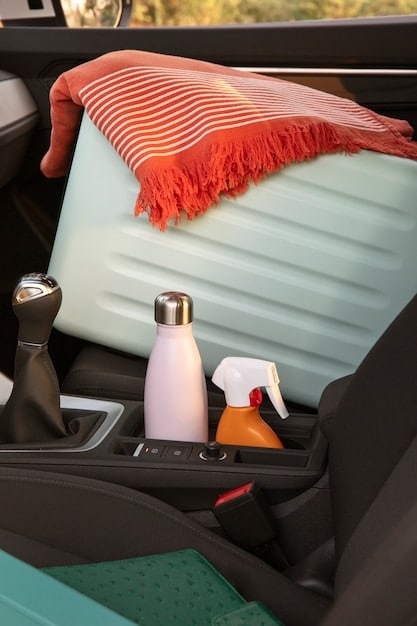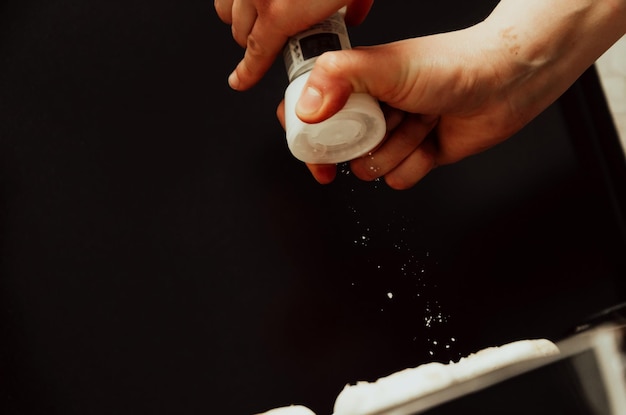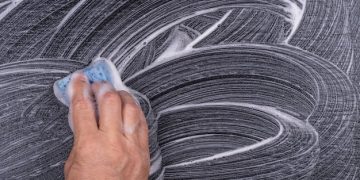DIY Car Odor Removal: Eliminate Lingering Smells for Good

DIY car odor removal is achievable by identifying the odor source, ventilating the vehicle, and using household items like baking soda, vinegar, or coffee grounds to neutralize and eliminate lingering smells effectively.
Is your car plagued by lingering odors that just won’t go away? Don’t worry, you don’t need to spend a fortune on professional detailing. With the right techniques and a few common household items, you can master DIY car odor removal: eliminate lingering smells for good and enjoy a fresh, clean ride.
Understanding Car Odors and Their Sources
The first step in effective DIY car odor removal is understanding what causes those unpleasant smells. Identifying the source allows you to target your cleaning efforts and prevent future odors.
Common Culprits Behind Car Odors
Several factors can contribute to the build-up of bad smells in your car. These range from everyday occurrences to more persistent issues.

- Food and Drinks: Spills, wrappers, and forgotten leftovers are a major source of odors.
- Pets: Pet hair, dander, and accidents can create lingering smells.
- Smoke: Cigarette or other types of smoke can permeate the car’s upholstery and ventilation system.
- Mold and Mildew: Moisture build-up, especially in carpets and upholstery, can lead to mold and mildew growth.
- Mechanical Issues: Problems like coolant leaks can also cause distinctive odors.
By pinpointing the most likely culprits, you can focus your cleaning efforts on those specific areas.
Essential Tools and Products for DIY Car Odor Removal
Before diving into the cleaning process, it’s important to gather some essential tools and products. Most of these are readily available at home or at your local grocery store.
Must-Have Cleaning Supplies
Equipping yourself with the right supplies will make the odor removal process much more efficient and effective.
- Vacuum Cleaner: A strong vacuum with attachments is crucial for removing loose debris and dirt.
- Microfiber Cloths: These are excellent for wiping down surfaces and absorbing spills.
- Spray Bottles: For applying cleaning solutions and odor neutralizers.
- Baking Soda: A natural odor absorber that can be used on carpets, upholstery, and hard surfaces.
Having these supplies on hand ensures you’re prepared for any odor-causing situation.
The Baking Soda Method: A Natural Odor Absorber
Baking soda is a powerhouse when it comes to natural odor absorption. Its alkaline properties neutralize acidic odors, making it a safe and effective option for your car.
How to Use Baking Soda for Odor Removal
Baking soda can be used in several ways to tackle various car odors. Here’s a simple step-by-step guide.

- Vacuum the Car: Start by thoroughly vacuuming the entire car interior, including carpets, seats, and crevices.
- Sprinkle Baking Soda: Generously sprinkle baking soda over the affected areas.
- Let it Sit: Allow the baking soda to sit for at least a few hours, or preferably overnight, to absorb the odors.
- Vacuum Again: Vacuum up the baking soda completely.
This method is particularly effective for absorbing odors from spills, pet accidents, and smoke.
Vinegar Solution: Neutralizing Strong Odors
Vinegar, particularly white vinegar, is another excellent natural odor neutralizer. Its acidity helps to combat alkaline odors and disinfect surfaces.
Using Vinegar Safely and Effectively
When using vinegar, it’s important to dilute it properly and test it on a small, inconspicuous area first to ensure it doesn’t damage the car’s materials.
- Dilute the Vinegar: Mix equal parts white vinegar and water in a spray bottle.
- Spray Lightly: Lightly spray the solution onto surfaces, avoiding excessive saturation.
- Wipe Down: Wipe the surfaces with a clean microfiber cloth.
- Air Out: Allow the car to air out completely to dissipate the vinegar smell.
Vinegar is effective for removing musty smells, smoke odors, and general grime.
Coffee Grounds: Aromatic Odor Masking
Coffee grounds can be a surprisingly effective and pleasant way to mask and absorb certain odors. They offer a natural, aromatic alternative to synthetic air fresheners.
Employing Coffee Grounds as an Air Freshener
Used, dry coffee grounds can be repurposed to combat odors in your car. Here’s how:
- Dry the Grounds: Ensure the coffee grounds are completely dry to prevent mold growth.
- Place in a Container: Place the dried grounds in an open container, such as a bowl or jar.
- Position Strategically: Place the container in your car, ideally in an area where the odor is strongest.
- Replace Regularly: Replace the coffee grounds every few weeks to maintain their effectiveness.
Coffee grounds are particularly effective for masking smoke odors and providing a fresh, clean scent.
Professional Detailing vs. DIY: Making the Right Choice
While DIY methods can be highly effective, sometimes professional detailing is necessary for stubborn or deeply ingrained odors. Understanding the pros and cons can help you make an informed decision.
When to Call in the Experts
Certain situations may warrant professional attention to ensure thorough odor removal and prevent further issues. Consider professional detailing if:
- You’ve Tried DIY Methods Without Success: If you’ve exhausted your DIY options and the odor persists.
- The Odor is Strong and Pervasive: If the smell is overwhelming and deeply embedded in the car’s materials.
- Mold or Mildew is Present: Mold and mildew can be difficult to eradicate completely without professional equipment.
- You Suspect a Mechanical Issue: If the odor is related to a car malfunction like a coolant leak.
Professional detailers have access to specialized equipment and cleaning solutions that can tackle even the toughest odors, but DIY methods are a great first step.
| Key Point | Brief Description |
|---|---|
| 💨 Identify Odor Source | Pinpoint the cause of the smell to target cleaning efforts. |
| 🛠️ Essential Tools | Gather vacuum, microfiber cloths, spray bottles, and baking soda. |
| 🌱 Natural Solutions | Use baking soda, vinegar, or coffee grounds to absorb odors. |
| 📞 When to Call Experts | Consider professional detailing for stubborn odors or mold issues. |
Frequently Asked Questions
▼
For best results, leave baking soda in your car overnight. This gives it ample time to absorb and neutralize odors effectively. If the odor is particularly strong, you can leave it for up to 24 hours.
▼
When properly diluted (equal parts vinegar and water) and used sparingly, vinegar should not damage your car’s interior. Always test it on an inconspicuous area first, and avoid saturating surfaces.
▼
Yes, some odors, such as those caused by mold, severe pet stains, or mechanical issues, may require professional detailing. These odors are often deeply embedded and need specialized treatments.
▼
Regular cleaning is key to preventing odors. Aim to vacuum your car at least once a month and address spills immediately. Deep cleaning every 3-6 months can also help maintain a fresh-smelling interior.
▼
Most commercial air fresheners only mask odors with a stronger scent. For true odor elimination, it’s best to use natural solutions like baking soda or vinegar, which neutralize the odor at its source.
Conclusion
By following these DIY **car odor removal** tips, you can effectively eliminate lingering smells for good and maintain a fresh, clean vehicle. Remember, the key to success is identifying the source of the odor and using the appropriate cleaning method. With a little effort and some common household items, you can enjoy a pleasant driving experience without breaking the bank.





